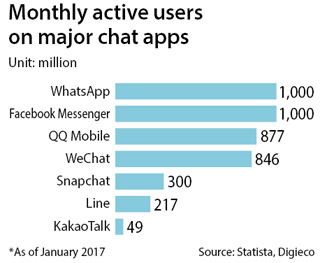Chatbots can do more than just chitchat

Korea’s largest delivery company CJ Logistics announced on Thursday that it has introduced a chatbot service to handle customer inquiries on delivery schedules, parcel packaging methods, parcel delivery rates and more.
Given an inquiry that says, “When will my parcel arrive?” through a simple text message on a smartphone app or via the chatbot tab on CJ Logistics’ online homepage, the chatbot will immediately reply something along the lines of, “Hello, the delivery will be made on Nov. 9 between 2 p.m. and 3 p.m.”
The new service was developed using artificial intelligence, machine learning and natural language processing technology. The combination of the technologies makes it easier for the robot to understand queries that use different wording and nuances.
“We trained the chatbot with our big data accumulated through numerous types of customer inquiries registered through our call centers,” a spokesperson from CJ Logistics said. “Using the natural language processing technology, we trained the bot to offer most suitable answer to customers regardless of varying expressions.”
Unlike call centers, the chatbot runs 24 hours a day without resting; enabling consumers to access information they need at any time. The logistics company’s future goal is to upgrade the chatbot with voice recognition technology so it can also be of more use to couriers as well.
“We plan to develop a chatbot catering to couriers, so it can notify them of the delivery address, parcel type and specific demands from customers via spoken conversation,” the company said in statement.
CJ Logistics is the most recent company to jump onto the chatbot trend. While the service was first adopted mostly in the financial sphere to replace call centers, it is spreading to a larger range of industries and even the public sector.
CJ HelloVision, the operator of budget mobile phone carrier Hello Mobile, introduced its own consulting chatbot, dubbed “Woody,” last week. Using the chatbot, customers can instantly get advice on what phone plan or mobile device to use and how much their phone bill is this month. As the chatbot is also based on AI and machine learning, it gets smarter over time by accumulating diverse conversational data.
“Customers can avoid the hassle of spending hours visiting offline shops or on the phone and at the same time get simple and well organized answers from the chatbot,” a spokesperson from CJ HelloVision said.
Retailers including home shopping companies are also actively making use of chatbot services to make shopping more convenient. CJ O Shopping and GS Home Shopping are companies operating chatbots that work through Kakao Talk. Using a special feature of the chat app dubbed “Plus Friend,” consumers can make direct orders and inquiries to shops.
More popular global chat apps like Facebook’s Messenger and Chinese Tencent’s WeChat also offer similar services matching companies with a list of consumers on their chat platform.
According to market tracker TechNavio, the global chatbot market is expected to reach $3.17 billion by 2021, growing at an average 37 percent annually over the next few years.
BY KIM JEE-HEE [kim.jeehee@joongang.co.kr]










with the Korea JoongAng Daily
To write comments, please log in to one of the accounts.
Standards Board Policy (0/250자)